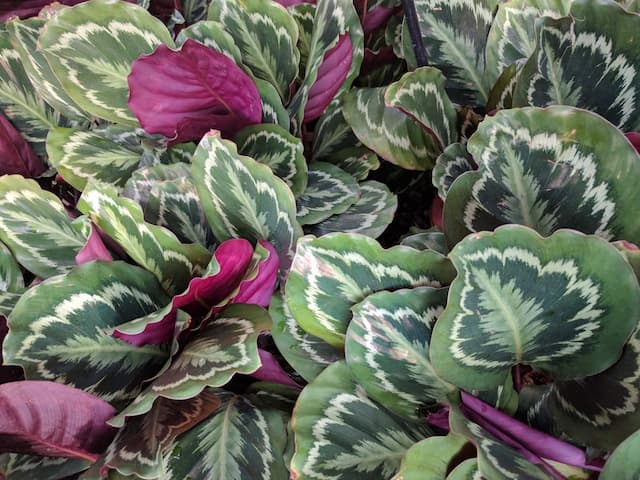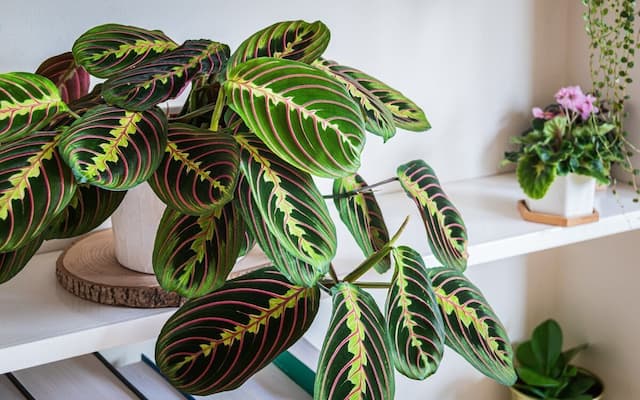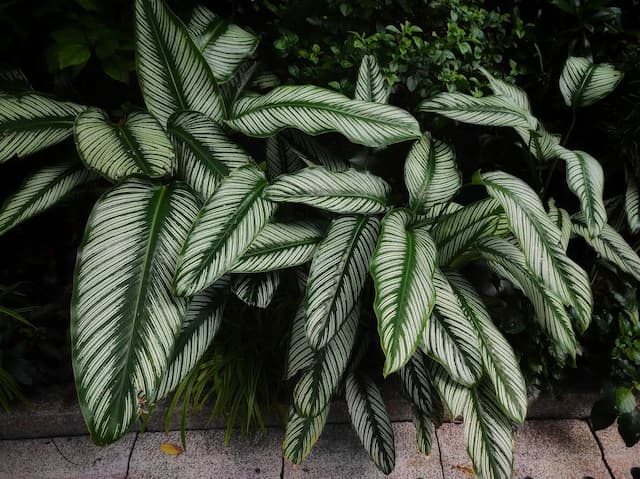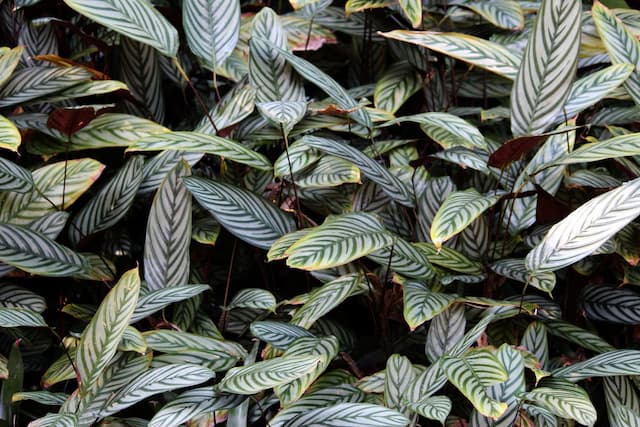Never Never Plant Ctenanthe lubbersiana

ABOUT
The Ctenanthe lubbersiana, commonly known as the "Bamburanta", is an ornamental plant prized for its striking foliage. The plant carries an array of large, oval-shaped leaves that are held upright on long, slender stems. Its leaves showcase a beautiful variegation with patterns that resemble brush strokes. The majority of the leaf surface displays a light green or yellowish color, punctuated by different shades of green. This variegation creates a lively mosaic, with some leaves exhibiting a more solid color and others adorned with irregular dark green patches or stripes. The undersides of the leaves are often a contrasting shade, usually a purplish or reddish color, adding another layer of visual interest when the leaves are viewed from below or as they sway in a breeze. This dual-toned effect is particularly enchanting and contributes to the plant's popularity among houseplant enthusiasts. The Bamburanta has a bushy, clumping nature which gives it a lush, tropical appearance, making it an excellent choice for adding a touch of greenery to indoor spaces. Its visual appeal is not just in the colors but also in the patterns and the overall vibrant presence it brings to a plant collection. The detailed patterning and color contrasts of the Bamburanta leaves make it a striking specimen in any room or garden where it's used for decorative purposes.
About this plant
 Names
NamesSynonyms
Never-Never Plant, Bamburanta, Golden Mosaic Plant, Yellow Vein Plant.
Common names
Stromanthe lubbersiana, Phrynium lubbersianum, Calathea lubbersiana.
 Toxicity
ToxicityTo humans
The Ctenanthe lubbersiana, commonly known as the Bamburanta, is generally not considered toxic to humans. There is limited information about its toxicity, but it is not included on toxic plant lists and there are no common reports of poisoning from this plant. However, it's always prudent to keep houseplants out of reach of small children who might chew on leaves, as any non-food plant material can potentially cause gastrointestinal discomfort if ingested in large quantities.
To pets
Bamburanta is considered non-toxic to pets, including cats and dogs. There is no evidence to suggest that this plant poses a significant risk of poisoning if pets chew on or ingest its leaves. As with humans, though, it is wise to monitor your pets around houseplants to prevent any potential digestive upset that could occur from eating non-edible plant material.
 Characteristics
CharacteristicsLife cycle
Perennials
Foliage type
Evergreen
Color of leaves
Variegated
Height
2-3 feet (60-90 cm)
Spread
2-3 feet (60-90 cm)
Plant type
Herb
Hardiness zones
10
Native area
South America
Benefits
 General Benefits
General Benefits- Aesthetic Appeal: Ctenanthe lubbersiana, commonly known as the "Never Never Plant," has distinctive variegated leaves that add a tropical feel and visual interest to indoor and outdoor spaces.
- Low Maintenance: It is relatively easy to care for, requiring minimal maintenance, which is ideal for busy plant owners or those with limited gardening experience.
- Humidity Tolerance: This plant thrives in humid conditions, making it well-suited for bathrooms or kitchens where humidity levels are higher.
- Enhances Well-being: Incorporating greenery like the Never Never Plant can enhance the overall well-being by creating a more serene and natural environment.
 Medical Properties
Medical PropertiesThis plant is not used for medical purposes.
 Air-purifying Qualities
Air-purifying QualitiesThis plant is not specifically known for air purifying qualities.
 Other Uses
Other Uses- Artistic Inspiration: The vibrant patterns on the leaves of the Never Never Plant are often used as a motif or inspiration in textile design, graphic design, and visual art.
- Teaching Tool: Botany educators might use the Never Never Plant to teach students about variegation and plant pigmentation.
- Photography Subject: Due to its unique leaf patterns, the Never Never Plant is a popular choice for plant photography and social media featuring exotic plants.
- Eco-Friendly Packaging: Some small-scale producers could use dried leaves to create natural, biodegradable packaging for small items.
- Themed Events: The Never Never Plant can be used as a decoration for jungle or tropical-themed parties and events due to its lush appearance.
- Set Design: Theater and film productions set in tropical locations might use Never Never Plants to create an authentic-looking set.
- Aquarium Camouflage: Although not an aquatic plant, its leaves could be replicated in synthetic form to provide natural-looking camouflage in freshwater fish tanks.
- Boutique Store Displays: Given its striking appearance, the Never Never Plant can be used in boutique store displays to create an attractive ambiance.
- Religious Symbolism: In certain cultures, plants with striking patterns like the Never Never Plant might be used as symbols in religious or spiritual ceremonies.
- Insect Habitat: In garden settings, the dense foliage of the Never Never Plant can provide shelter for beneficial insects.
Interesting Facts
 Feng Shui
Feng ShuiThe Never-Never Plant is not used in Feng Shui practice.
 Zodiac Sign Compitability
Zodiac Sign CompitabilityThe Never-Never Plant is not used in astrology practice.
 Plant Symbolism
Plant Symbolism- Persistence: The Ctenanthe lubbersiana, commonly known as the 'Never Never Plant,' symbolizes persistence due to its ability to thrive in various environments and its resilience in indoor settings.
- Adaptability: This plant adapts well to different levels of light and watering conditions, making it a symbol of adaptability and flexibility in life's changing circumstances.
- Varied Beauty: With its variegated leaves that feature a mix of green, yellow, and white colors, the Never Never Plant represents the beauty of diversity and the unique blend of traits that each individual has.
 Water
WaterThe Never-Never Plant should be watered once the top inch of the soil feels dry to the touch, typically every week to ten days, depending on environmental conditions. When watering, do so thoroughly until water starts to drain from the bottom of the pot, indicating saturation. In terms of the amount, this can vary depending on pot size, but a good rule is to use approximately 16-32 ounces of water for a medium-sized plant. During the winter months, reduce the frequency of watering as the plant's growth slows and it requires less moisture.
 Light
LightThe Never-Never Plant thrives best in bright, indirect light. This means it should be placed in a spot where it can receive plenty of light without being exposed to direct sunlight, as intense rays can scorch its leaves. An east-facing window with sheer curtains or a few feet away from a south-facing window would provide ideal lighting conditions.
 Temperature
TemperatureThe Never-Never Plant prefers temperatures ranging from 65 to 80 degrees Fahrenheit and should not be subjected to temperatures below 55 degrees Fahrenheit to avoid cold damage. The ideal room temperature for this plant would be around 70 to 75 degrees Fahrenheit. It's also important to protect the plant from drafts and sudden temperature changes.
 Pruning
PruningPrune the Never-Never Plant to maintain its shape and remove any yellow or damaged leaves. Pruning can be done at any time of the year, but the best time is during the spring or early summer when the plant is actively growing. Deadheading, or the removal of spent flowers, will encourage more blooms and keep the plant looking fresh.
 Cleaning
CleaningAs needed
 Soil
SoilThe Never Never Plant prefers a well-draining, peat-based potting mix with good aeration. Mix two parts peat moss with one part perlite or coarse sand to improve drainage. The ideal soil pH for Ctenanthe lubbersiana is slightly acidic, ranging from 6.0 to 6.5.
 Repotting
RepottingNever Never Plants should be repotted once every 1-2 years, or when the plant has outgrown its current container. Spring or early summer is the best time for repotting to allow the plant to settle in before the growth period.
 Humidity & Misting
Humidity & MistingNever Never Plant thrives in high humidity environments, ideally between 60% and 80%. These conditions can be achieved by using a humidifier, placing a tray with wet pebbles underneath the pot, or regular misting.
 Suitable locations
Suitable locationsIndoor
Provide indirect light, high humidity, and water Never Never Plant when topsoil dries.
Outdoor
Grow in shade, protect from cold, and ensure soil stays evenly moist.
Hardiness zone
10-12 USDA
 Life cycle
Life cycleCtenanthe lubbersiana, commonly known as the Bamburanta, begins its life as a seed germinating in warm and moist soil conditions. Once the seedling emerges, it develops into a young plant with characteristic variegated leaves that unfurl from the central stem. As it matures, the Bamburanta grows taller and produces more leaves, expanding through rhizomes that allow the plant to spread across the soil. In its adult stage, the Bamburanta rarely flowers indoors, but when it does, it produces small, inconspicuous flowers that are not the primary attraction of the plant. Over time, older leaves may yellow and die, allowing for new growth to take their place. Eventually, as with all plants, the Bamburanta will reach the end of its life cycle, but it can live for many years and propagate through division or cuttings, thus continuing its species.
 Propogation
PropogationPropogation time
Spring-Early Summer
Propogation: The Ctenanthe lubbersiana, commonly known as the "Never Never Plant," is often propagated during the spring or summer months when the plant is actively growing. The most popular method of propagation for this ornamental houseplant is by division. To propagate by division, you should gently remove the plant from its pot and separate the rhizomes, ensuring each section has a few leaves and roots attached. After division, plant each section into its own pot filled with a well-draining potting mix, water thoroughly, and maintain the humidity around the plant. It's important to keep the newly potted divisions in a warm, indirect light environment while they establish. This propagation method is very effective for the Never Never Plant and typically results in a high success rate, making it a favorite among plant enthusiasts.




